 |
| |
|
| |
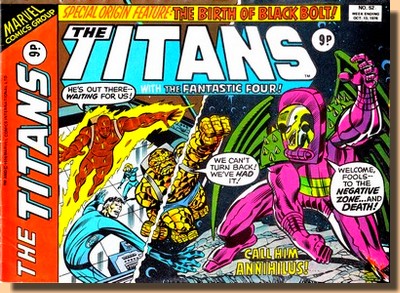 |
|
MARVEL UK
INSIDE
THE
TITANS #52
OCTOBER
1976
|
|
| |
| Launched in September 1972, Marvel Comics' UK imprint
(commonly known and refered to as Marvel
UK) enjoyed immediate success, and a steadily
growing number of titles reprinted US material following
the standard 1970s UK comic book market format of weekly
publication and black and white printing. In late October 1975, Marvel UK added
another weekly title to its range of publications (the
seventh in total and the fifth superhero mag) when The
Titans was launched, featuring a number of
well-known Marvel characters such as Captain America,
Captain Marvel, the Sub-Mariner, the Inhumans, and Nick
Fury Agent of S.H.I.E.L.D.
But the real novelty of Titans
was its 8.5" x 11" (21.6 cm x 28 cm)
landscape format, which made it possible
to reprint two original pages side by side on one extra
wide page. Whilst this made the individual panels of a
story appear rather small, it gave Titans readers
an amazing amount of reprint material per issue for their
money, as a closer look at the 36 pages of The Titans
#52 (on sale the week of October 13th 1976) illustrates.
|
| |
| |
FANTASTIC
FOUR
"Death in the Negative
Zone!"
Originally
published in
Fantastic Four #109
(April 1971)
Script - Stan
Lee
Pencils - John Buscema
Inks - Joe Sinnott
Lettering - Sam Rosen
Original page count: 19
Reprinted pages: 19
|
|
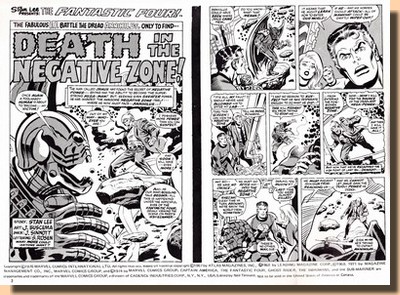
|
|
| |
| Ever since the launch of Marvel UK readers in Britain
were used to having several characters feature in one
comic book title. As a consequence, the individual
storylines in one issue could be as short as five or six
pages. Given the weekly publication schedule this didn't
really make the stories any harder to follow than e.g.
with the monthly pause between two US originals, but it
did create a distinct segmentation.
The landscape
format of The Titans, however, effectively
doubled the page count of original material which could
be reprinted, and readers were thus treated to a full
length rendition of one original US issue of the leading
character. This first slot had been filled by Captain
America, Nick Fury, the Sub-Mariner, Captain Marvel, Iron
Man, the X-Men in earlier issues of The
Titans,
but as of issue #30 it fell predominantly to the
Fantastic Four.
|
| |
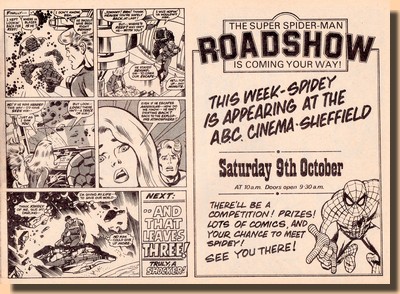 |
|
"Death in the Negative
Zone!" comes from one of the first FF issues
after Jack Kirby left Marvel, but John Buscema's
pencils painted a vivid picture of a dramatic
Stan Lee story as Reed, Johnny and Ben travel
into the Negative Zone to stop Annihilus from
succeeding in finding a pathway to the positive
universe (i.e. ours). As the conflict mounts,
Reed sends Ben and Johnny back through the
portal, leaving himself caught between the
barrier, and Annihilus... drifting further into
the Negative Zone and towards certain death in
order to insure that the monster doesn't find the
portal to our world - and providing us with what
must surely be one of the most dramatic FF final
panels ever.
Reprinting an entire original issue in The
Titans called for no extra editorial or
in-house artwork at all, but as the original page
count was uneven the end page only filled half of
a landscape page.
|
|
| |
| This space was used either for standard
advertisements or, to a lesser degree, for in-house
announcements - in this case the Super Spider-Man
Roadshow. |
| |
| |
GHOST
RIDER
"At the Mercy of Zodiac
!"
Originally
published in
Ghost Rider #7
(August 1974)
Script - Tony
Isabella
Pencils - Jim Mooney
Inks - Jack Abel
Lettering - Alan Kupperberg
Total page count: 18
Reprinted pages: 9
Original story title: "...And lose his own
Soul!"
|
|
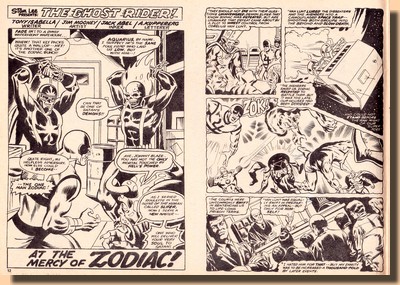
|
|
| |
| Ghost Rider had been introduced to the readership of
Marvel UK's titles in The Titans #31 (May 1976)
and was the most recent material to be reprinted in its
pages. In this story, Tony Isabella pits Johnny Blaze
(who is joined by the former Daredevil antagonist
Stuntmaster) against a villain who goes by the name of
One Man Zodiac. Not unlike Johnny Blaze, he sold his soul
- in his case to be granted amazing powers for one full
year. |
| |
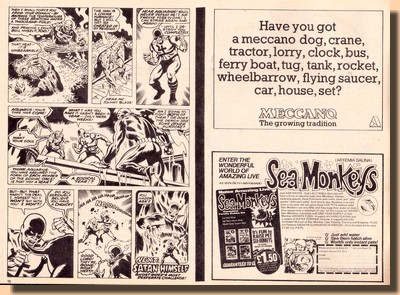 |
|
Battling the Ghost Rider and
Stuntmaster, the One Man Zodiac shapeshifts from
one sign of the Zodiac to another when the demon
appears to claim his soul - because as Zodiac
changed into all the signs he "passed
through a full Zodiac year". As both the
Demon and the One Man Zodiac disintegrate, Ghost
Rider is once more confronted by Satan himself... Reprinting
the second half of the original material
pencilled by Jim Mooney for Ghost Rider
#7, a newly produced splash page was required as
lead for the feature. Such pages were required
frequently for UK reprint material (as it more
often than not cut an original US issue into two
or even three segments), and their quality varied
heavily. In this case, however, there is no
discrepancy as luck - and Jim Mooney - provided
the UK editorial with a splash page in the
original material which could be turned into the
required intro page by simply pasting the
character headmast, creator credits plus a title
onto the original page.
|
|
| |
| A not so elegant trait which was specific to the
landscape format Marvel UK titles was a rather
conspicuous black bar running from top to bottom in the
centre of some but not all pages - an erratic feature
which did nothing to enhance the overall impression of
the landscape layout design. Again, the odd number of
pages left half a landscape page free for ads - or two,
in this case. Both Meccano and Sea Monkeys are long since
gone, but how could we ever forget them...
|
| |
| |
CAPTAIN
AMERICA
"Cap goes Wild !"
Originally
published in
Captain America #106
(October 1968)
Script - Stan
Lee
Pencils - Jack Kirby
Inks - Frank Giacoia
Lettering - Sam Rosen
Total page count: 20
Reprinted pages: 12
|
|
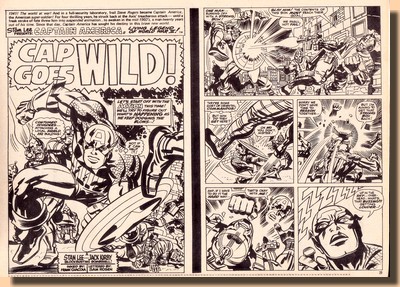
|
|
| |
| The third feature of Titans #52 presents the
first 12 of a total of 20 pages of classic Stan Lee and
Jack Kirby Captain America fare which revolves around a
communist plot (though for once originating in Red China)
to seize S.H.I.E.L.D.'s latest generation of LMDs, i.e.
life model decoys, in order to discredit Captain America
and the free world leaders. Even though the iron
curtain was, of course, still firmly in place in 1976,
the "commie plot" theme was an exception for
Marvel by 1968 (when the original story was published).
Frequently used in early Thor and Iron Man issues, the
House of Ideas soon realized that super villains and
their own brand of evil schemes made for far more
colourful antagonists. In this case, some of the
spectacle was infused by way of the location as Cap goes
to Hollywood to foil production of a damningly
discrediting movie using a Steve Rogers / Cap LMD.
|
| |
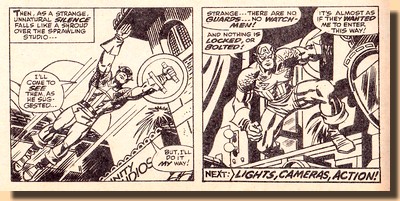 |
|
That part of the story, however,
would be left to the next issue of Titans
and the final 8 pages of the original material.
Pushing
the pause button was usually fairly easy for
Marvel UK editorial as they would simply insert -
as illustrated here - a text box at the bottom of
the original panel reading "NEXT: ...".
What readers did get to see in the first 12
pages of "Cap goes wild" was a guest
appareance by Chairman Mao - although ironically
he had died only a month before his cameo was
reprinted in Titans #52.
|
|
| |
| Together with the Fantastic Four story this is the
A-List Marvel material reprinted in Titans #52 -
although I distinctly remember that reading it as a
12-year old I was completely unimpressed and, besides
much prefering the Don Heck Captain America I knew from
Avengers reprints to Jack Kirby's, felt that the
preceding Ghost Rider story had a lot more zap and wham
to it. |
| |
| |
PRINCE
NAMOR THE SUB-MARINER
"The Chaos and the Crown !"
Originally
published in
Sub-Mariner #12
(April 1969)
Script - Roy
Thomas
Pencils - Marie Severin
Inks - Marie Severin
Lettering - Herb Cooper
Total page count: 20
Reprinted pages: 9
Original title: "A World against Me !"
|
|
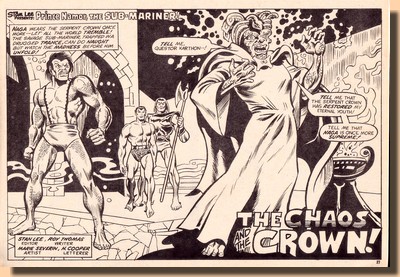
|
|
| |
| In terms of the history of Marvel Comics the
Sub-Mariner is a pivotal and important character. He was
Marvel’s first superhero, first anti-hero and first
mutant, all in one. He has been an Avenger, an Invader, a
Defender and more recently even an X-Man. Prince Namor,
King of Atlantis, has been around for a very long time,
and any time Marvel celebrates an anniversary (such as 75
years in 2014), the Sub-Mariner can claim the same. And
yet he has never quite enjoyed the enduring success of
other A-List Marvel characters since the 1960s and more
often than not been something of a dark horse, only
rarely enjoying runs in a comic book title of his own. |
| |
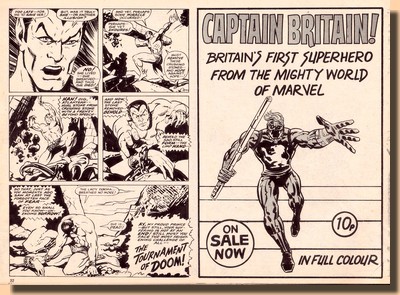 |
|
"A World against Me !"
from Sub-Mariner #12 (the
last 9 pages of which are reprinted as fourth
feature in Titans #52) stems from
possibly the most memorable run of all, when Roy
Thomas gave Namor depth and edge in the very late
1960s and artists such as John Buscema, Gene
Colan and Marie Severin gave the stories
cinematographic quality. In this chapter
Naga, emperor of a water breathing humanoid
Lemurian race and bearer of the Serpent Crown
(which has changed his physical appearance into
resembling a snake) battles Namor, who must also
withstand the illusions set forth by the Serpent
Crown. During the fight, the fair Lady Dorma is
accidentally killed by Namor...
Once again, the odd number of pages leaves
half a landscape page free for ads, which in this
case is put to good use to sound the drums for
the launch of Marvel's very own British hero - Capatin
Britain - and the first weekly from Marvel UK
to feature full colour pages.
|
|
| |
| Being the last third of an original US issue, this
feature's segment required some form of custom intro
page, and here editorial opted for a full size landscape
splash page which also served to recap the rather complex
storyline. |
| |
| |
THE
INHUMANS
"... And Finally: Black Bolt !"
Originally
published in
Thor #148
(January 1968)
Script - Stan
Lee
Pencils - Jack Kirby
Inks - Joe Sinnott
Lettering - Sam Rosen
Total page count: 5
Reprinted pages: 5
|
|
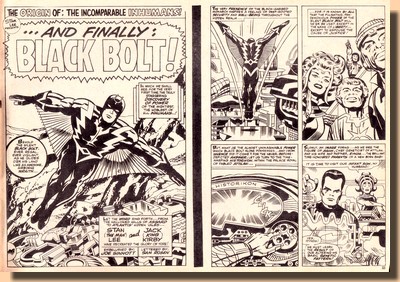
|
|
| |
| The contents of Titans #52 come to a close
the same as they started - with a full reprint of an
entire original US feature. Although "full
reprint" in this case still accounts for the lowest
page count as "... And finally: Black Bolt!" is
a backup feature from the 1968 run of Thor which
as of issue #146 had switched from the Tales of Asgard to
the Inhumans. Another Lee / Kirby classic, I again have a
distinct recollection of having had no sense of
excitement whatsoever when reading this back in 1976... |
| |
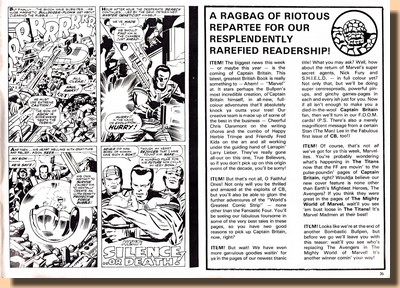 |
|
Once again the landscape format
in conjunction with an odd page count left half a
page to be filled, and this one - on the inside
back cover - featured Marvel UK's version of the
Bullpen Bulletins, or in the words of editor Neil
Tennant (who would ultimately
find fame and fortune with the Pet Shop Boys
five years later) "a ragbag of riotous
repartee for our resplendently rarefied
readership"... The big news, of course,
was Captain Britain and the splash of colour
coming to black and white Marvel UK, but Titans
readers could also note that this issue's
headline act, the Fantastic Four, would be moving
to the new Captain Britain weekly and be replaced
by the Avengers.
This was rather typical for Marvel UK's
editorial policy amongst a stream of merging
weekly titles and changed lineups. Readers could
never be quite sure that the next issue of a
certain weekly title would continue to feature
all characters in its next issue.
|
|
| |
| All in all, however, readers of The Titans
had few reasons to complain. The landscape format gave
them an incredible amount of stories and number of
characters a week for 9 pence - in fact virtually double
from what the regular format reprint titles would offer
for the same price. From a business perspective one
might wonder where exactly the publisher's gain was to be
found in this formula, but The Titans had
actually been joined by a second landscape format weekly
title, Super Spider-Man with
The Super-Heroes, in February 1976.
Ultimately the two landscape weeklies merged in October
1976, to become Super
Spider-Man and The Titans. When this in turn became
Super
Spider-Man & Captain Britain in July 1977
(following the cancellation of Capatin Britain's own
weekly), the title reverted from landscape back to
standard.
The fact that this oddball format (which didn't work
that well on newsagent racks either) lasted for more than
18 months is all the more surprising as one of Marvel
UK's constant worries and woes was the fact that the
weekly publication schedule meant they were often
catching up on the original material way too fast for
comfort.
|
| |
Marvel UK wasn't all reprint,
though. Leaving aside Captain Britain, a lot of
splashpages and covers were produced in Marvel's
New York offices for the British weeklies.
"Larrupin'
Larry Lieber (...) has also come aboard to
handle the issues which we produce for an
ever-growing army of Marvel fanatics in Great
Britain. Wouldja believe they're on sale weekly
over there; so we're bettin' that Larry'll be
kinda busy." (Stan's Soapbox,
September 1976 Bullpen Bulletins,
Marvel [US] Comics)
Stan Lee's brother had, in fact, already been
quite busy for Marvel UK even before taking on
the job as
editor of
Marvel's British department, pencilling covers
and other material (such as the cover of Titans
#51, inked by Frank Giacoia).
|
|
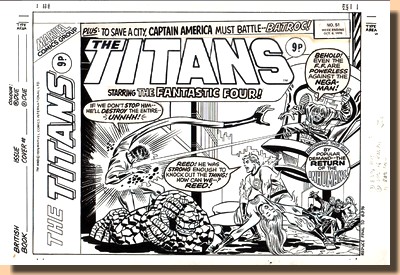
|
|
| |
| Due to its unusual format The Titans is not
a truly typical example of a mid-1970s Marvel UK weekly,
which would commonly never see a complete US issue
reprinted in one go because the standard concept would
feature at least three (if not more) different characters
and hence storylines within the 36 pages of a weekly
title, resulting in the segmentation of one US issue over
two or three issues of the Marvel UK title. |
| |
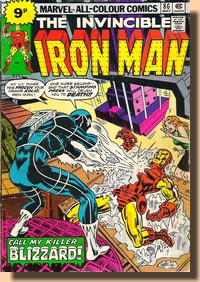 |
|
In this respect, the landscape
format of the Titans was a real game
changer for as long as it lasted.
What
remained absolutely unchanged, however, was the
black and white rendering which was, of course,
quite unlike the original. This was a point the
UK price variants were eager to make on their
covers with their MARVEL
ALL-COLOUR COMICS headmast. By mid-1976
these special UK market print runs (also known as
"pence price variants", they were
completely identical with the US issues other
than having a pence price and the different
headmast caption on the cover) were becoming more
widely and more reliably available, so the lack
of colour in the UK reprints was more
highlighted.
Did that cut into Marvel UK's sales? Some
experts seem to think so. In my case, I happily
picked up and bought the UK Titans #52
as well as the US pence price Iron Man
#86 - both for 9p - from the same newsagent
during a holiday in the Scottish Highlands.
Firstly because the comic book market was nowhere
near as saturated as it is today. And secondly,
because both had their distinct appeal - so if
you got the opprtunity and had the pocket money
required, chances were you'd go for both the
original US and the UK reprint offerings.
|
|
| |
|
| |
 |
|
There's more on
the history of Marvel UK in the
1970s here. |
|
|
|
| |
 |
|
There are more
reviews of Marvel UK titles and
issues on this site, you can find
a list here. |
|
|
|
| |
 |
|
There's
more on the background
and history of
"Pence Price
Variants" here. |
|
|
|
|
| |
|
| |

|
| |
The illustrations presented here are
copyright material
and are reproduced for strictly non-commercial
and appreciative review purposes only.
This Thought Balloon content (c) 2014-2022
First published on
the web 27 October 2014
Updated and revised 6 February 2022

|
|
| |
|
| |

















